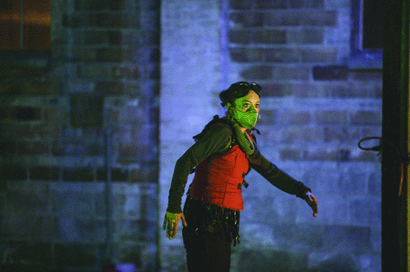The intense environmental awareness of “Catalyst”
Emily Johnson grew up in the wild open spaces of Alaska. While her U.S. contemporaries were hanging out at the mall, Johnson was hiking and mountain biking on the Kenai Peninsula. Part Yup’ic Eskimo, she and her family fished from remote beaches, picked cranberries from the local bogs, even hunted moose.
“Since all my dances deal with something personal, environmental concerns were bound to come up sooner or later,” said Johnson, 30, who began making dances in the 1990s as a student at the University of Minnesota. “The Exxon Valdez oil spill emotionally affected me and many Alaskans. When you are involved in nature, when you live inside its cycles and currents, you actually feel it when nature is adversely affected.”
Johnson certainly knows about living inside of a community powerfully linked to nature and its processes. “We relied on a week of fishing to supply the entire extended family for the winter,” said the soft-spoken Johnson. “We also relied on it to bring all the family from different parts of Alaska together. The process of the fishing itself—catching, scaling, gutting, brining, smoking, canning—would take the whole family into the wee hours of the morning. And we had to wait for Grandma’s okay for each phase.”
Communal process has been central to the creation of “Heat and Life,” which deals with the affects of global warming. In 2003, Johnson took her company Catalyst, seven powerhouse female performers who have worked with Johnson for several years, to develop the work in the great outdoors. As they staggered up Wisconsin hills and slogged through Alaskan cranberry bogs, the choreography developed the kind of muscular grit that characterizes Johnson’s movement vocabulary.
As the company worked, Johnson made room in the rehearsal process for people to drop by and ask questions. “People were curious, and we had many conversations, pro and con, about their views on global warming,” said Johnson. Now every performance is followed by a discussion of global warming, often with guest experts and activists such as Emmett Pepper of Citizens Campaign for the Environment, who will join Johnson for post-show discussions at DTW.
The work, which was co-commissioned and presented by the Walker Art Center in Minneapolis, premiered in 2004 at an industrial warehouse on the Mississippi River. The audience stood around as performers wearing bright orange jumpsuits, goggles, and masks squawked out desperate messages on walkie-talkies—“We’re missing a dancer. Please stand by. Everybody get out of here.” To an ominous sound score played by composer JG Everest on a variety of instruments and enhanced by electronic looping and shrill-to-excruciating industrial noises, the dancers created a post-apocalyptic world. Illuminated by industrial flashlights, dancers moved at maximum voltage, flailing around the dusty space as if jolted by alien currents. They erupted in spasmodic moves, or huddled furtively in corners.
At the first performance fire alarms were inadvertently triggered, and fire trucks raced to the scene with sirens blaring and lights flashing. “People thought it was just part of the event,” laughed Philip Bither, performing arts curator at Walker Art Center, who has long admired Johnson’s confidence and fierceness. “She has a clear vision of where she wants to go, and uncompromising intensity,” he added. “She’s saying something new through a powerful movement vocabulary relevant to her generation.”
The intensity of the work, which will have its first performance in a traditional theater at DTW, is somewhat alleviated by moments of sharp wit. At a recent rehearsal in Minneapolis, one dancer ordered the others to “Take 19 steps toward the Hudson River. Take cover. Stand up. Fall down. Find a power source. Cover your mouth. Lift your left shoulder.” The rapid-fire directives read like a sinister childhood game. That fits with Johnson’s penchant for game structures, which evolved from her experiences as a serious teenage athlete.
“As in basketball, I set plays within which we improvise,” said the petite and deceptively fragile looking Johnson. “These dancers know my work intimately. They know how a piece is supposed to build, expand, come down, explode.”
While improvisation figures into the process, Johnson’s movement vocabulary is rigorously specific. “I like to create strict boundaries around my movement.” And indeed, there is no release here—only energized, high-powered dancing. When the performers rest, it’s with exhausted wariness, as if they are priming themselves for the next disaster. Johnson suggests the idea of land space diminishing as sea levels rise—an effect of global warming—through a claustrophobic sense of dancers having their physical space constantly encroached upon. Videotaped sequences of rural and urban landscapes enhance the sense of loss and disorientation.
gaycitynews.com


































